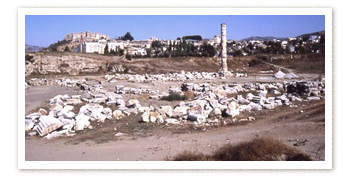The Bee and the Deer
Greek cities often used animals as identifying symbols on their coins. For this purpose Ephesus used both the bee and the deer ( 11 , 12 ).
The deer is an animal sacred to Artemis, and Artemis was Ephesus' patron goddess just as Athena held this role at Athens. The popular Greek image of Artemis was as a huntress, and she can be shown riding a deer ( 13 ), in a chariot drawn by deer, subduing a stag with her bare hands ( 14 ), or with a little deer at her feet ( 15 ). Even when the Ephesian Artemis appears in her stiff hieratic Anatolian form, two deer can stand like heraldic symbols on either side, looking up at her ( 15 ).

The site of the Artemision
The bee was associated with Ephesus for many reasons. According to the writer Philostratos, Imagines 2.8, the Athenians who came to colonize Ionia, where Ephesus is located, were led by the Muses, who took the shape of bees. Artemis' priestesses were called melissai or "bees" of the goddess (Inschriften von Ephesus 2109), and were directed by "king bees" (essenes), priests who served a year-long term under strict rules of purity (Pausanias 8.13.1); the ancient Greeks and Romans didn't realize that the leader of a beehive is a queen, not a king.
When the Ephesian Artemis appears in her stiff Anatolian format, bees are often shown on her belt or tight skirt. Indeed, D.G. Hogarth, who excavated the earliest levels of the sanctuary found gold ornaments, some in the shape of bees, that could have been attached to an image's garments. Some scholars trace the Ephesian Artemis back to an earlier Anatolian goddess whom the Hittites called Hannahanna, who sent a bee to wake up the god Telepinu from sleep/death. On Ephesus' early silver coins, the bee appears alone on the obverse, with only an incuse stamp on the reverse. ( 16 )
